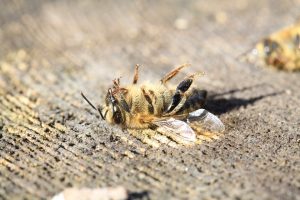17
Apr
Despite Safety Claims, Insecticide Flupyradifurone Is Bee-Toxic on Its Own and Worse in Combination

(Beyond Pesticides, April 17, 2019) A neurotoxic pesticide labeled “bee-safe” has been found to be harmful to bees, according to a new study. Flupyradifurone (FPF), the subject of the study, is a novel chemical that was hastily registered in the wake of public awareness about the impact of neonicotinoid insecticides on bees. A systemic insecticide and a nicotinic acetylcholine receptor (nAChR) agonist, it functions in the same way as a neonicotinoid, though it is in the butanolide family. “Lethal and sublethal synergistic effects of a new systemic pesticide, flupyradifurone (Sivanto®), on honeybees,” not only debunks the myth that FPF is safe on its own, it also delves into the FPF’s synergistic effects with a commonly used fungicide propiconazole (PRO). PRO, on its own, has no impact on bee mortality. A rarely studied realm of pesticides, the study defines a synergistic effect as, “when combined exposure to two factors results in an effect that is significantly greater than the sum of individual effects.”
Researchers manipulated six healthy honey bee (Apis mellifera ligutica) colonies and observed the impact of varying amounts of pesticide exposure, including both individual and synergistic effects, on behavior and mortality. They recorded data over seasons and between worker types.
A field-realistic dose of FPF caused a 73% mortality in bees when combined with the fungicide PRO. The synergy of the two pesticides increased abnormal behaviors (motor coordination deficits, hyperactivity, apathy, curved-down abdomen, moribund). The pesticides were more toxic to foragers than in-hive bees and were more toxic in the summer versus the early spring.
Toxicity results for FPF in this study were higher than those reported by the Environmental Protection Agency (EPA), likely due to a difference in protocol. EPA’s risk assessment does not require a thorough assessment of abnormal behaviors and measure behavioral changes up to four hours after treatment – when the effects have often already worn off. These researchers looked closely at the honey bee behaviors one hour after exposure, when abnormal behaviors are more likely to be exhibited.
Lead author Simone Tosi, PhD told Newsweek, “This work is a step forward toward a better understanding of the risks that pesticides could pose to bees and the environment. We provide the first demonstration that the combination of two pesticides can synergistically increase the frequency of pollinators with abnormal behaviors, and suggest methodologies that could be implemented for assessing the risks caused by pesticides.”
The impact of combinations of chemicals is potentially enormous and often overlooked. As mentioned in Beyond Pesticides’ Action of the Week on mixtures, “When pesticides are sprayed on our crops, lawns, and roadsides, and enter into our waterways, groundwater and drinking water, we are exposed to whole formulations, whole tank mixtures, and whole pesticide combinations, not just active ingredients (those that the manufacturer claims are the only ingredients that attack the target pest).” While not well understood and poorly regulated, a few studies have been done that show negative impacts of synergistic effects.
For example, Warren Porter, PhD., professor emeritus of zoology and environmental toxicology at the University of Wisconsin, Madison, examined the effect of fetal exposures to a mixture of 2,4-D, mecoprop, and dicamba exposure. These chemicals, frequently combined in lawn products, had a strikingly deleterious impact on mice reproduction.
Similarly, Tyrone Hayes, PhD, found reproductive effects on frogs when they were exposed to mixtures of chemicals. “…only atrazine causes the hermaphroditism, but when atrazine has all of its little friends along, you are exposed to atrazine longer. So the combination of chemicals is not synergistic in a way that it is causing more hermaphroditism, but they are delaying development so that the atrazine exposure is longer and increasing the effects.”
Beyond Pesticides has been on the case of flupyradifurone since its registration in 2015. As the public becomes aware of the harm that particular classes of insecticides have on pollinators – not to mention entire ecosystems and/or human health – new chemicals with different nomenclature but similar effects will always pop up in their place. Beyond Pesticides therefore advocates for a paradigm shift from “whack-a-mole” pesticide bans to organic policy that precludes toxic chemicals entirely. An organic approach alleviates the need to analyze just how destructive synergistic effects are.
All unattributed positions and opinions in this piece are those of Beyond Pesticides.
Sources: Newsweek, Proceedings of the Royal Society B










